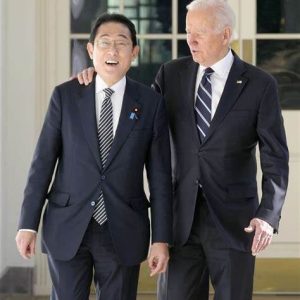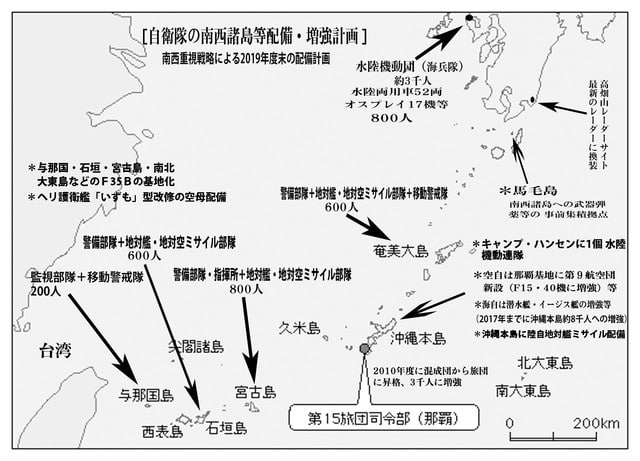The combined real gross domestic product (GDP) of China and Russia is now 1.3 times that of the United States. This grim fact has dramatically changed the military situation in the Western Pacific. The U.S. forces stationed in Japan, which were supposed to defend Taiwan and Japan (the Senkaku Islands), have withdrawn to the U.S. mainland and Guam. The United States, which had lost its financial leeway, had no intention of confronting China and Russia head-on. Therefore, as Shinzo Abe said in his will, ``an emergency in Taiwan is an emergency in Japan.'' Liberal Democratic Party Vice-President Taro Aso, who visited Taiwan, argued, "For peace and stability in the Taiwan Strait, it is necessary to have a strong deterrent, and for that reason, Japan, the United States, and Taiwan must be prepared to fight." However, the "Japan, the United States and Taiwan" that Aso, the king of rants, is correct is "Japan and Taiwan" without the United States. This was due to the US offshore balancing strategy, and Aso was merely running errands for it. The reality of the 78th anniversary of Japan's defeat in the war was the complete dismantling of "postwar Japan's pacifism."
■ US Offshore Balancing Strategy and Japan
Washington, upon receiving the three Security Treaty documents pledging Japan to become a military superpower by doubling its defense budget and maintaining its ability to attack enemy bases, said, ``Japan stood up on its own,'' and ``I took responsibility for national defense on my shoulders.'' Praised. The core strategy of the US military, which has been promoted under the name of the realignment of US forces in Japan since 20 years ago, has been offshore balancing. Applying the US offshore balancing strategy to the Asia-Pacific region is nothing less than making Japan bear the responsibility of countering China's threat.
Therefore, behind the scenes of Japan-U.S. negotiations, the U.S. directly or indirectly ``abandoned the assumption that ``Japan will protect the United States from China,'' and prepared to respond to the situation of ``East Asia after the U.S. forces left''. should have been advising Japan to proceed with The destination was "Taiwan emergency is Japan emergency". The United States cannot fight China, another nuclear superpower. It will not lead to a mutually destructive nuclear war.
 January 14, 2023. Washington DC. President Biden put his hand on Prime Minister Kishida's shoulder, saying, "Good job, good job." Then Kishida let out a servile smile that he had never shown before (picture). 78 years after its defeat in the war, the reality of Japan being ruled by the United States, both physically and psychologically, was vividly shown.
January 14, 2023. Washington DC. President Biden put his hand on Prime Minister Kishida's shoulder, saying, "Good job, good job." Then Kishida let out a servile smile that he had never shown before (picture). 78 years after its defeat in the war, the reality of Japan being ruled by the United States, both physically and psychologically, was vividly shown.
At that time, the joint statement by the leaders of Japan and the United States cleverly interspersed Washington's "encouragement" with the words, "Japan, stand up on your own." “The United States and Japan continue to be called upon to strengthen their individual and joint capabilities. Commended Japan's bold leadership in fundamentally strengthening its power and strengthening its diplomatic efforts, which strengthen security in the Indo-Pacific and the international community as a whole, and modernize Japan-U.S. relations for the 21st century. That is what you will do.
“Japan will strengthen its defense capabilities independently and demonstrate bold leadership in the East Asia and West Pacific regions.” This is the completion of the Japanese version of the US offshore balancing strategy. Washington described it as "modernizing US-Japan relations for the 21st century."
■The United States avoids war between great powers
Now, the Greek, Roman, and Western European civilizations that crossed the Atlantic Ocean and reached North America spread across the Pacific Ocean to China and Russia. In the mid-nineteenth century, the United States proclaimed this as a "Manifest Destiny." With the end of the Cold War between the East and West at the end of the 20th century, Z. Brzezinski and others advocated the conquest of Eurasia by the United States, which became the world's first sovereign hegemonic nation, in "The Grand Chessboard American Primacy and Its Geostrategic Imperatives 1997," and others. In response, they devised a strategy of ignoring sole hegemony. Namely, the United States has revived the slogan Manifest Destiny, which was used to justify global territorial expansion to become the first non-Eurasian state to control Eurasia.
In his 2006 book, The Peace of Illusions: American Grand Strategy from 1940 to the Present, American political scientist Christopher Lane illustrated the offshore balancing strategy that the United States had embarked on. At its core, it is to insulate the United States from potential great power wars in Eurasia. The United States, which lured Eurasian core Russia from the Arab Spring through the color revolution to the war in Ukraine, is "isolated from great power wars." Consistently pursue proxy disputes against Xinjiang Uyghur, Tibet, Hong Kong and China, and the US military will never be directly involved in wars, and will not engage in unnecessary wars for the sake of subordinate countries. mentioned. In fact, Biden has made it clear many times since he took office that he will not fight China and that he will not go to war with Russia.
According to Lane, the offshore balancing strategy consists of (1) placing major Eurasian powers in charge of national defense; will take the initiative to stop it. The risks and costs of maintaining hegemony have increased dramatically. I fear that it will fall just like the empire. In other words, offshore balancing is essential to win the competition for economic hegemony between the United States and China. In a February 2011 speech at the U.S. Military Academy, then-Secretary of Defense Gates advocated that "offshore balancing is America's next big strategy." We will uphold the Japan-U.S. Security Treaty, never allow Japan to acquire nuclear weapons, and treat Japan as the frontline military power in Taiwan's defense and as the "leader of the China Containment Alliance." This is the US offshore balancing against Japan, and it is driving Japan into a serious crisis. The first step was to set up a missile base for the Self-Defense Forces, which was targeted by the Chinese military, at the expense of the residents of the Nansei Islands, and decided to double the barren defense budget.
■U.S. forces begin to withdraw from the Western Pacific
April 2020, the U.S. military has launched a new concept called the Dynamic Force Operations Concept, withdrawing the B-52 strategic bombers from Guam to the U.S. mainland. This withdrawal is said to be a strategic change due to the evolution of China and North Korea's missiles, but to be precise, it means to leave the missile range. In addition, the US Marines stationed in Okinawa are expected to start relocating to Guam in 2024. For the time being, a certain number of U.S. Marines will head to Guam under the guise of reducing the burden on Okinawa, which is the centerpiece of the restructuring of U.S. forces in Japan. With the 2015 new security legislation that made it possible to exercise the right of self-defense, joint use with the Self-Defense Forces has become possible, and many of the US troops stationed in Guam are expected to withdraw further to the US mainland.
In addition, it is said that there was a confidential agreement that the Ground Self-Defense Force will be permanently stationed at the new Henoko base, which is currently under construction to replace the U.S. Marine Corps Futenma base in Ginowan, Okinawa. Japan's Ministry of Defense denies that "there is no agreement between the Japanese and American governments," but in 2010, when the Democratic Party of Japan was in power, then Defense Minister Toshimi Kitazawa held a press conference to consider joint use by the U.S. military and the Ground Self-Defense Force. was clearly stated. Based on the offshore balancing strategy, it can only be seen that the deployment and operation of US forces are being changed according to US interests and financial constraints. The “Guidelines for Japan-U.S. Defense Cooperation” was revised in 2015, specifying “strengthening joint use” of bases. Japan and the United States are increasing joint exercises at US military and Self-Defense Force bases in Japan. The US military bases that the US military has withdrawn will become Self-Defense Forces bases with the name of "joint use".

Therefore, Taro Aso's remarks calling on Japan and Taiwan to be "prepared to fight" can only be regarded as provocative rants at the heart of the US power.
